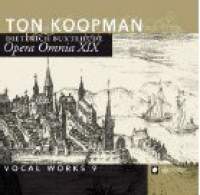Texte paru dans: / Appeared in: |
|
| "The set is recommended with enthusiasm." |
Outil de traduction (Très approximatif) |
|
|
|
|
Reviewer: J.
F. Weber
The first disc above has three cantatas never recorded before by my count: 1, 30, and 106. The other pair of discs has seven unrecorded works: 22, 80, and 103 on one and 23, 88, 117, and 118 on the other. When Mogens Wöldike recorded BuxWV 10 on October 28, 1936 in anticipation of the composer’s tercentenary, the thought that all these works would eventually be heard on records must have been inconceivable. Even so, 10 more were recorded on shellac, but it took 65 years to fill in the rest. Koopman’s renditions are generally sung one voice to a part: The Amsterdam Baroque Choir is used only for BuxWV 1 in Volume 9 and for BuxWV 23 in Volume 10. There are quite a few works for a solo voice: BuxWV 105, 95, and 83 in Volume 9 and BuxWV 115, 17, 84, 118, 28, 117, and 35 in Volume 10. One might expect singers to be attracted to these pieces, but only BuxWV 35, 84, 95, and 105 gained much attention in the past. Aksel Schiøtz sang the last on one shellac side and, most recently, Emma Kirkby included it in her CD. Helen Boatwright and Hugues Cuénod took on the more substantial BuxWV 35. Ethel Luening’s BuxWV 84 was a prewar shellac disc, one of the first two recordings of these works made in America (again, for the tercentenary), followed by Peter Pears and Emma Kirkby (in the same CD). Koopman’s ensemble singers do not enjoy the international reputations of such singers, but their work is creditable. Koopman uses high pitch (a’=465) as Buxtehude preferred, while much Baroque music is now recorded at a’=415, and he uses mean-tone tuning with period instruments, so this is the complete set of reference. Comparing the extensive discography one work at a time is a dissertation-level exercise for which I will defer to someone else. The set is recommended with enthusiasm. | |
|
|
|
|
Cliquez l'un ou l'autre
bouton pour découvrir bien d'autres critiques de CD |
|




